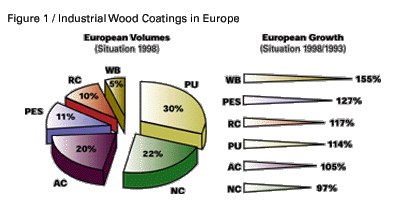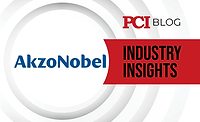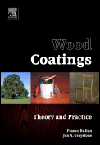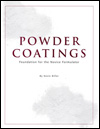Wood Coatings For The Furniture Industry


Reasons for the success of radiation curing include the outstanding performance of the coatings, very fast curing (within seconds or fractions of seconds), product stability on the application machines, low process costs per square meter of surface, and the very low emissions. These explain why radiation-curable coatings have obtained an important market share alongside other systems like nitrocellulose, two-component polyurethane, acid cure and waterborne coatings.
When the UV/EB technology was introduced into the furniture industry, the main application method was the roller coater. This was due to the highly viscous nature of the resins that were on the market at that time. In the meantime, binders with lower viscosity were developed, which enabled the use of other coating techniques like spray, curtain and vacuum coating.
Similar to the resin developments, a lot of progress was made in the photoinitiator field and with curing equipment. The appearance on the market of photoinitiators with an absorption spectrum shifted to the visible light, and the introduction of high intensity lamps and doped lamps, has largely increased the use of radiation curing in pigmented systems.
Over the last years, the major developments have been in combinations of existing technologies, such as radiation curing with waterborne systems or powder coatings.
In this article, some furniture formulations are presented for different kinds of application techniques, both in clear and pigmented systems. These formulations contain 100%-UV products as well as UV-curable, waterborne products.

Adhesion On Wood And Intercoat Adhesion
As with conventional coatings, it is necessary in radiation-curing systems to apply several layers of coating to get a satisfactory finish. Consequently, in addition to considering adhesion on wood, intercoat adhesion and substrate preparation must be considered. Sanding of the wood is very important to achieve an optimum adhesion. A pretreated surface will aid adhesion and will allow a nice coating with a minimum film thickness to be obtained. Sanding is normally done with aluminum-oxide sanding belts.Primer systems on wood can be based on 100%-UV products or on UV-curable waterborne products. Some flexible epoxy acrylates based on bisphenol A give very good results. Formulations based on these products penetrate less into the porous surface of the wood, which is sometimes a problem because of migration of uncured parts. When a very high adhesion level is required, the amount of epoxy acrylate can be increased up to 60%, such as in the formulation shown in Table 1. However, in this case the formulation or the rollers need to be heated because of the high viscosity of these products.
Several waterborne systems also give excellent results in primer formulations. Acrylic emulsions and polyurethane acrylates in dispersion (UV-PUD) combine very low viscosity with good adhesion. Both the emulsions and the dispersions need to be physically dried before curing. With the UV-PUD primer formulation excellent adhesion is obtained on oak, beech, ash, iroko, afromosia, rovema, wenge, cabreuva, ovangkol, doussie afrika, cabreuva vermeila and roveme. Only on teak was the adhesion insufficient.
Closer to the 100%-UV systems are the water-dilutable UV resins. Water-dilutable, aliphatic urethane acrylates, which can contain up to 50% of water, give excellent adhesion on a variety of wood. The viscosity of these products can be adjusted with lower-molecular-weight, water-dilutable resins. These are normally polyether acrylates. The advantage of primers based on these products is that water evaporation is not necessary, even when they contain 50% water. The water is taken away by absorption into the wood and through evaporation by the heat of the UV-lamps.
Sometimes polyisocyanates are used to improve the adhesion on difficult types of wood. By blending 5% of an aliphatic polyisocyanate with a UV primer it is possible to crosslink UV material that is not irradiated by UV light or is inhibited by chemicals in the wood. The viscosity of these blends can be stabilized by adding small amounts of acid functional acrylates.
Good intercoat adhesion is obtained by correct sanding and/or by undercuring of the surface. The latter can be done by using only limited amounts of amines or by using low-intensity UV sources. Of course the coating needs to be mechanically sandable, which becomes possible by adding extenders like talc, calcium carbonate or crystalline silica. The undercured layer will be fully cured after irradiation of the next coating layer or layers.

Clear Coatings On Natural Wood
As mentioned, most of the early applications in the radiation-curing domain were with roller coaters. In the past, these roller coaters had the application and dosing rolls synchronized with the transport belt. Currently, they have three independent rolls. This has opened the way to variations in coating thickness and to smoother coatings. With the arrival of application rolls with lines (optiroll system) it has become possible to apply thicker coatings and still have a very nice flow.

UV Clear Coatings For Open Pores By Roller Coater
For this type of coating a system was developed with one or two sealer coats and one topcoat. The first sealer layer is applied in a thickness of 20–25 g/m2 and the optional second sealer in a thickness of 10–15 g/m2. Sanding was done between layers. The sealer can be based on epoxy acrylate chemistry or on polyester chemistry. For the topcoat a combination of an epoxy acrylate and an aromatic urethane acrylate was chosen. As an alternative a topcoat with a polyester acrylate is given.The viscosity of the formulations in Table 2 is around 2,400 mPa•s at 20°C. It is also possible to work with a lower viscosity formulation. An example is given of a three-layer coating (3x7 g/m2), with only one formulation. This formulation contains a mixture of a bisphenol A-type epoxy acrylate and an amino-modified polyether acrylate. Intercoat sanding is only done before applying the top coat.
UV Clear Coatings For Closed Pores By Roller Coater
For this application, use was made of a roller coating with smoothing roll. This development enabled a closed-pore aspect with low coating thickness to be achieved. 25 g/m2 was applied for the sealer, followed by scuff sanding and another 10 g/m2 of the same sealer formulation. Again scuff sanding was done and finally 8 g/m2 of the topcoat was applied by a conventional roller coater.
UV-Curable, Waterborne, Clear Coatings For Open Pores By Spray
The low-solids content and the low viscosity of a waterborne coating allow a nice open-pore finish even on 3D substrates by spraying. With the type of UV-curable polyurethane dispersion that was used, a tack-free surface is obtained after physical drying so that dust collection is minimized and handling is easier. The final properties are only obtained after UV curing. At this stage the coatings show excellent adhesion, and chemical and scratch resistance.The optimum coating thickness seems to be 60–70 g/m2. A higher thickness leads to difficult water removal with the risk of bubbles and a milky appearance caused by residual water. In this case, the water is trapped inside the coating by skin formation at the top of the coating.
For our tests the coatings were dried by circulation of warm air: first 7–8 minutes at 40°C and then 2–3 minutes at 50°C. More sophisticated drying systems are also on the market. Dry air ovens exist where the air is freeze dried at –10 to –15°C. The dried air is then recycled into the drying tunnel at 30–40°C, thereby increasing the drying speed and efficiency of the process. Medium- or near-infrared and macro-wave drying are also possible, but sometimes orange peel or other surface defects result.
To get a high-quality finishing, two to three coats are necessary, depending on the type of wood (three for beech, two for sapelli). The first and the second coat must be sanded after UV curing. The coating has an excellent adhesion on wood and even stained wood, where 100%-UV coatings can fail. Another advantage of these dispersions is that it is easier to get a matte effect than with pure UV-systems. On the other hand, it is not possible to reach the same high gloss levels as with 100%-UV systems.

100%-UV Clear Coatings For Closed Pores By Spray
It is also possible to obtain a closed-pore aspect of the wood by spray application of a 100%-UV formulation. On porous wood like beech, this requires three coats of about 70 g/m2 with intermediate curing and sanding.

100%-UV Clear Coatings For Closed Pores By Curtain Coater
By curtain coater, a coating weight of 80–100 g/m2 is applied. For this application technique, a viscosity of 60 seconds in DIN 4 at 20°C is required and the film appearance is strongly influenced by the curing conditions. Due to the high thickness, it is necessary to use a low photoinitiator content and to cure at low UV intensity. In this way it is possible to slow down the surface curing. When the surface is cured too rapidly, the combination of the solid surface with the liquid bulk of the coating leads to wrinkling or other surface defects.
Pigmented Coatings On Fiberboard And Natural Wood
The problem in pigmented coatings for wood is the in depth curing with UV light. Even when relatively thin layers (e.g., 20m) are applied directly onto the wood, the real thickness can locally be much higher because of penetration into the wood and surface irregularity. The problem becomes even more pronounced when profiled substrates are to be coated. Therefore, it is common practice to keep some safety margin in film thickness and/or pigmentation level.To ensure complete curing in all parts of the coating, several possibilities exist. Photoinitiators are used that absorb more of the longer wavelengths emitted by the UV lamps. These wavelengths are absorbed or reflected to a lesser extent at the surface of the coating and represent the major part of the radiation energy in the depth of the coating. To increase the proportion of the longer wavelengths even more, Hg lamps doped with Ga or other elements are frequently used in pigmented applications.
For thicker coatings or coatings with high pigmentation levels it is also advisable to use lower concentrations of photoinitiator. If the photoinitiator level is too high, too big a part of the UV-light is absorbed by the upper layers of the coating, leading to incomplete curing of the depth of the coating. This can cause adhesion problems or migration of uncured material. Dual curing mechanisms are another way to overcome the problem.
For formulations containing alcohol functionality, the possibility exists to add polyisocyanates. These functionalities will continue to react long after the UV exposure has stopped, and will guarantee a good crosslinking in the depth of the coating and even on spots, which cannot be reached by the UV light. One drawback of this approach is the limited potlife of these systems.

White, 100%-UV Finishing On Hardboard By Roller Coater
After sanding of the hardboard with SiC, 20 g/m2 of a slightly pigmented primer is applied and cured. Next, two layers, 15–20 g/m2 each, of a white pigmented sealer are applied with intermediate curing and sanding. Finally, 12 g/m2 of white topcoat is added to get a nice finish. The primer is again based on a flexible, epoxy acrylate, as already mentioned in the part on adhesion, and on a full acrylic. This type of product is often used as an adhesion promoter. In the sealer a special type of epoxy acrylate is used, which combines the hardness and reactivity of a bisphenol A epoxy acrylate with excellent pigment wetting properties. The topcoat is made with a trifunctional, aliphatic urethane acrylate. The result is a coating that combines decorative and protective properties.The white paste used in the primer consists of DPGDA (50), TiO2 R210 (50) and Disperbyk 110 (0.5).

Pigmented, Waterborne UV Formulation On Beech By Spray
For spray applications, UV-curable polyurethane dispersions offer the best possibilities. In these systems water is used to reduce the viscosity of the formulation instead of reactive diluents or solvents. The former frequently have a negative impact on the coating properties, while the latter are undesirable from an environmental point of view. With the formulations shown in Table 7, it is demonstrated that UV-PUD products can be used both in clear coatings (mentioned above) and in pigmented systems. The formulations are based on a polyurethane dispersion and white (TiO2), black (carbon black), red (naphthol) and blue (Cu-phthalocyanine) pigment dispersions. Three layers of 70 g/m2 wet were applied with a HVLP spray gun and with drying, curing and sanding before application of the next coat. Flash off for 6–7 minutes at 40°C and jet air drying for three minutes at 50°C were used.Conclusion
From the information presented in this article it can be concluded that the developments in binders, additives, photoinitiators, curing and application equipment have opened the door to a variety of applications in the furniture industry. The formulations presented represent good starting-point formulations for the actual and future users of radiation-curing technology and will possibly lead to a further spreading of this technology.Acknowledgement
The author would like to thank Jean-Pierre Bleus, Marc Decaux and their team for all the formulation and other work they did in preparing this presentation.This paper was originally presented at RadTech 1999 in Berlin, Germany. Full proceedings from RadTech are available from Gary Cohen, RadTech USA, radtech.seidel@bluewin.ch, for 110 euros.
For more information on wood coatings, phone Stephan Van den Branden at +11/322.3345.111; fax +11/322.3345.378.3944.
Looking for a reprint of this article?
From high-res PDFs to custom plaques, order your copy today!







